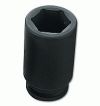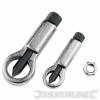
A guide to dealing with stuck fastenings, how to remove them without damage.
For removing rusty or seized fittings there are two things you can't have too much of,penetrating fluid and patience.
Don't forget most older cars were made before metric fixings became common place and you might need Imperial (SAE) spanners and sockets,check my spanner size conversion charts to make sure.With any restoration or repair work on an old classic car,bike or truck removing rusty or damaged nuts and bolts and fastenings can cause problems.The first essential is the correct sized, and good quality spanner or preferably socket .An open ended spanner will slip easily and damage the fixing,an adjustable will almost certainly round off the corners.Self grip wrenches,pipe grips and stillson type tools are best avoided as the potential to round off the fixing if they slip is very real. In most cases a six point socket (hex) will grip a rusted nut better,with less possibilty of damage than a twelve point socket (bi hex) or conventional ring end spanner.The fit should be as close as possible,preferably having to be pushed on . Hammering on an old socket a size down onto a badly rounded nut may sometimes work but may otherwise damage the nut even more. Start by cleaning off all old paint and as much rust and corrosion as possible with a decent scraper and wire brush,soak in a good quality releasing oil, my personal favourite is PlusGas, WD40 is not really a good release agent but better than nothing,automatic transmission fluid or diesel fuel are in the same category. Sometimes nuts and bolts can be removed by first attempting to tighten them so that they 'bite' on clean threads but if the fixing is already very tight this will not work. If the fastening still resists, heat from a blow or welding torch can be used.Tapping the fitting and the area around it with a small hammer can often dislodge hidden rust. Sometimes two or more applications of heat will be needed,the fixing should be heated to dull red heat then allowed to cool before attempting to remove,penetrating oil or fluid can be applied,the cooling process tends to draw the releasing fluid into the threads.Heat normally works wonders but can't obviously be used if there is a risk of damage or any danger of starting a fire.Rags soaked in water can be used to slow the transfer of heat to delicate components close to the area being worked on.Heating then dousing with water can sometimes loosen stubborn fittings as they expand and contract rapidly but be careful of the risk of damage by this process.

An impact socket.Six sided,impact sockets are normally black.Chrome vanadium sockets can shatter if used with impact drivers.
If the fixing is in good condition an impact driver and socket can be used.The socket should be a good fit and a purpose made impact socket (normally coloured black and six sided) .An impact driver is designed so that when struck with a hammer it both pushes down hard and imparts a turning movement to the socket to loosen the nut.Impact drivers are sometimes the only way to start rusted or tight phillips or pozidrive headed bolts or screws and will cope well if the head is slightly damaged.If an impact driver isn't available and you have to remove a cross headed fixing,then a 'drive thru' or 'strike thru' screwdriver where the shaft continues through the handle and can be struck with a hammer might achieve a similar result. For either method to work the fixing has to be fairly solid not on a body panel or similar where damage could result. The consequence of breaking or ruining a fixing makes patience a virtue,take your time and keep trying without using any excessive force. Smaller nuts that are rusted or seized can be removed by using a purpose made nut splitter. .

Nut splitter set.The cutting tool is driven into the nut by turning the hexagonal head on top of the handle.
If a nut splitter isn't available the nut can be drilled and split. Done carefully this will leave the bolt undamaged.Using a small drill perpendicular to bolt and in the centre of one of the nut flats,a hole is drilled through the nut.If the nut is a large one,two or more holes are drilled in a line across the flats,these holes are then enlarged using a bigger drill untill they touch or overlap.A sharp chisel is then used to split the nut which should then be easily removed.If the nut is on a flat surface it might be possible to use a hacksaw and cut the nut by sawing down close to the bolt.A replacement nut/bolt will have to be found,although if done carefully the bolt may be undamaged. The use of a fairly blunt chisel,or on smaller nuts a pointed punch will sometimes 'shock' a nut loose if the fixing is in something solid but the chance of damage is greater.The chisel is used at an angle to try and turn the nut and the impact may break the rust seal..Bolts or studs especially ones going through aluminium alloy can corrode badly.Heat and release fluid are the best form of attack,trying to remove as much corrosion as possible with wire brushes and scrapers helps the fluid penetrate.If the worst happens and a bolt breaks off flush you'll need drills and screw extractor set to remove the remaining part. if this doesn't work the hole will have to be drilled and repaired with a helicoil type insert and a new bolt or stud found.
Screw extractors are very hard and brittle steel,breaking one off in a stud will make the repair much more complicated as they are impossible to drill out with normal tools.If there is a stump proud of the surface stud extractors that clamp round the remains and are turned with a ratchet or spanner might remove it.If the stump is too small to grip, it will have to be filed or ground flat to use a drill and a screw extractor.
'Mole' or self grip wrenches,stillsons or pipe wrenches are the last resort on damaged fastenings,they can make the problem worse by damaging fastenings still further..If the nut is easy to get at,filing off the damaged flats may help a socket grip it.Sometimes if a nut and bolt are easy to replace it is quicker to cut them off with a slim cutting disc than spend time trying to unscrew them.WD40 and the like are fine for water dispersal but don't work as well freeing off seized fixings as something like Plus Gas or other purpose made freeing agents or even diesel fuel. Coca Cola is said to work but its really very dilute phosphoric acid so would take some time to work,if at all.
Tel (44)01472 353993
Click on computers to e-mail me.
For freeing off a seized engine click here, to return to home page go here.